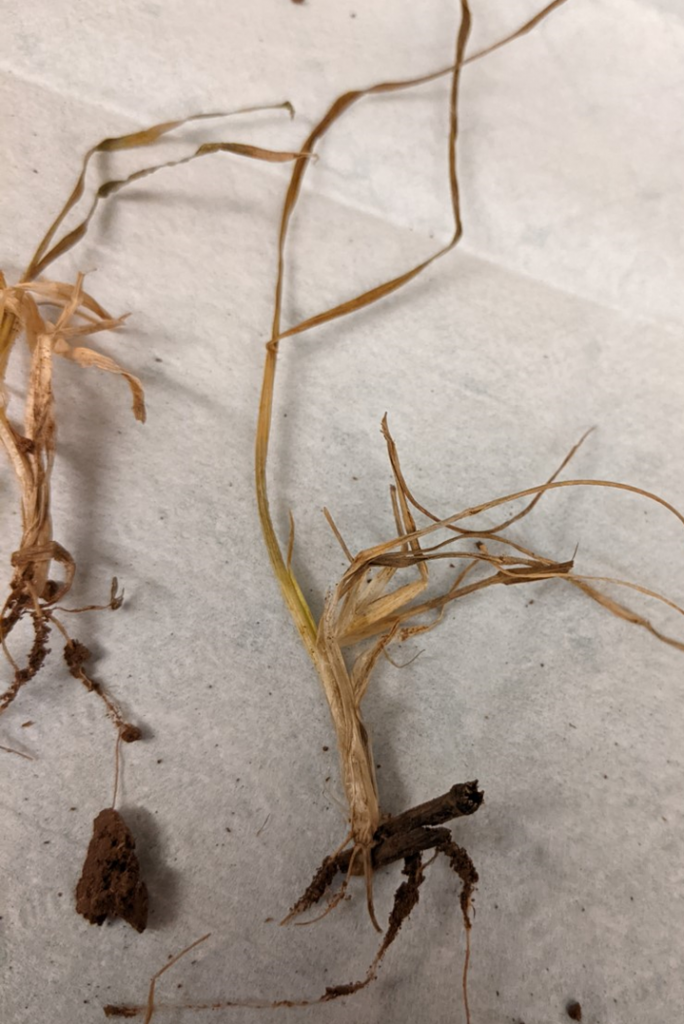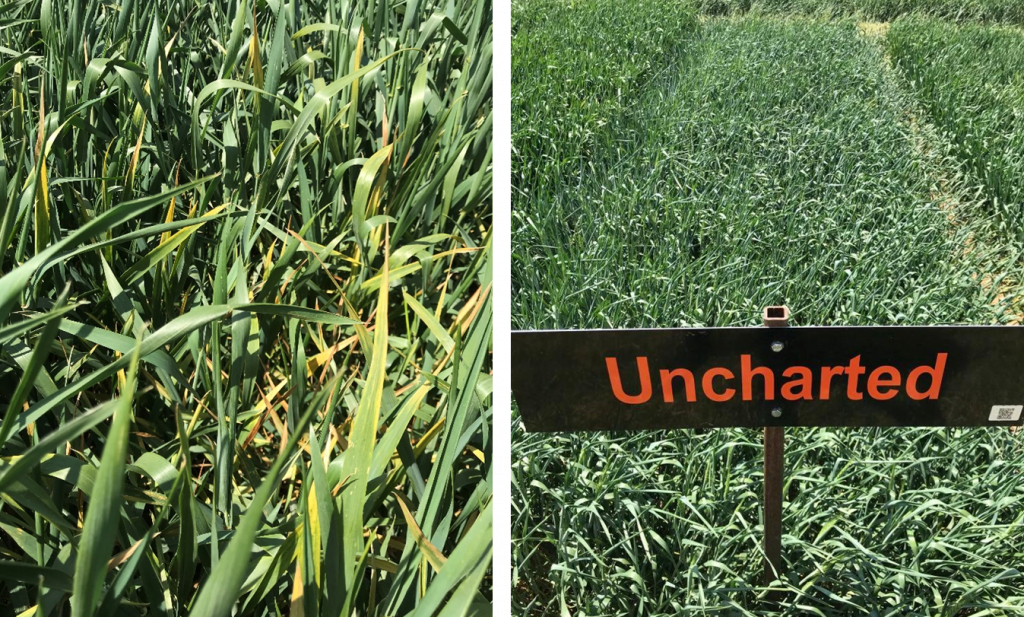Wheat Disease Update – 28 April 2022
Meriem Aoun, Small Grains Pathologist
Department of Entomology & Plant Pathology, Oklahoma State University
During April, the Plant Disease and Insect Diagnostic Laboratory at OSU received multiple wheat samples showing symptoms of streaking on the leaves. Leaf streaks were greenish yellow and parallel as shown in Figure 1. Enzyme linked immunosorbent assay (ELISA) on these samples from different wheat varieties were positive for wheat streak mosaic virus (WSM). WSM infected samples were from fields in multiple counties in Oklahoma including Payne, Blaine, Cimarron, Harper, Grady, and Garfield. A couple of samples that tested positive for WSM were also positive for high plains virus (HPV) and were from Harper and Blaine counties. Both WSM and HPV are transmitted by wheat curl mite. I also observed symptoms of barley yellow dwarf virus (Figure 2) in fields in Payne, Cleveland, and Grady counties.
 Figure 1. Wheat streak mosaic virus symptoms on the wheat variety ‘OK Corral’ (Grady County, April 13, 2022).
Figure 1. Wheat streak mosaic virus symptoms on the wheat variety ‘OK Corral’ (Grady County, April 13, 2022).
 Figure 2. Symptoms of barley yellow dwarf infection on the wheat variety ‘OK Corral’ in a farmer field in Cleveland County, OK (the photo was taken by Bradley Secraw, extension educator, at Cleveland County on April 26, 2022).
Figure 2. Symptoms of barley yellow dwarf infection on the wheat variety ‘OK Corral’ in a farmer field in Cleveland County, OK (the photo was taken by Bradley Secraw, extension educator, at Cleveland County on April 26, 2022).
I also observed leaf spotting on the wheat variety ‘OK Bullet’ in the Stillwater Agronomy Research Station. Culturing from the leaves resulted in the identification of the fungi Bipolaris sorokinana which causes spot blotch and Parastagonospora nodorum which causes septoria nodorum blotch. Parastagonospora nodorum was also recovered from leaf spots on leaves of the variety OK Corral in Cleveland County.
Around mid-April, the OSU Diagnostic Lab received a wheat sample from the variety ‘Doublestop’ from Blaine County. I examined the sample and I found that the infected plants were stunted and brown and showed weak root systems (Figure 3). Culturing from infected tissues identified Bipolaris sorokiniana which causes common root rot and Fusarium sp. which cause root, crown and foot rots. These fungi are favored by drought conditions in Oklahoma during the fall and spring.
 Figure 3. Common root rot and Fusarium root, crown and foot rots in a wheat sample from the wheat variety ‘Doublestop’ (Blaine County, April 13, 2022).
Figure 3. Common root rot and Fusarium root, crown and foot rots in a wheat sample from the wheat variety ‘Doublestop’ (Blaine County, April 13, 2022).
Wheat Disease Update – 21 April 2022
Meriem Aoun, Small Grains Pathologist
Department of Entomology & Plant Pathology, Oklahoma State University
In my previous update on April 12, I reported barley yellow dwarf virus (BYD) infection on the susceptible wheat variety ‘Pete’ in the BYD nursery in the Stillwater Agronomy Research Station. Last week, Dr. Amanda De Oliveira Silva (OSU Extension small grains specialist) observed yellowing of the leaf tips in most of the hard red winter wheat variety demonstration plots in Stillwater (Figure 1). We performed Enzyme linked immunosorbent assay (ELISA) on symptomatic samples from different OSU wheat varieties including ‘OK Corral’, ‘Strad CL Plus’, ‘Guardian’, ‘Baker’s Ann’, ‘Showdown’, and ‘Breakthrough’. All samples were tested positive for BYD. In these demonstration plots, the variety ‘Uncharted’, which carries two BYD resistance genes, Bdv1 and Bdv2, was the most resistant OSU wheat variety to BYD (Figure 1). Dr. Silva indicated that the plots planted earlier in September were more infected than the plots planted later in October. This shows the importance of breaking the ‘green bride’ to manage this virus which is transmitted by cereal aphids.
 Figure 1. The photo on the left shows Barley yellow dwarf (BYD) infection on the wheat variety OK Corral. The photo on the right shows the BYD resistant variety Uncharted which was planted next to other infected plots. The photos were taken in the hard red winter wheat variety demonstration plots in Stillwater, OK on April 15, 2022.
Figure 1. The photo on the left shows Barley yellow dwarf (BYD) infection on the wheat variety OK Corral. The photo on the right shows the BYD resistant variety Uncharted which was planted next to other infected plots. The photos were taken in the hard red winter wheat variety demonstration plots in Stillwater, OK on April 15, 2022.
During the last couple of weeks, the Plant Disease and Insect Diagnostic Laboratory at OSU received wheat samples from Garfield, Blaine, Cleveland, and Harper counties in Oklahoma and from an unknown location in Kansas state. I examined these samples and I observed yellowing and streaking indicative of viral infection (Figure 2). I did not observe any symptoms of fungal diseases on the leaves of the received samples. For the samples received from Garfield county and Kansas state, many of the leaves were dry and brown suggesting freeze damage (Figure 3).
Some of these samples were tested using ELISA for several viruses that affect wheat in the Great Plains. The sample from Cleveland county which was collected on the wheat variety OK Corral was positive for BYD. The sample from Kansas state (from the variety ‘Zenda’) and the sample from Garfield county (from the variety ‘WB 4401’) were tested positive for wheat streak mosaic virus (WSM). ELISA for the remaining samples from Blaine and Harper counties is in progress but the symptoms suggest WSM infection.
 Figure 2. Symptoms of wheat streak mosaic virus on the leaves of the wheat variety ‘WB 4401’ (Garfield county, Oklahoma on April 13, 2022)
Figure 2. Symptoms of wheat streak mosaic virus on the leaves of the wheat variety ‘WB 4401’ (Garfield county, Oklahoma on April 13, 2022)
 Figure 3. Freeze damage on the wheat variety ‘WB 4401’ (Garfield county, Oklahoma, photo by Kevin Brown on April 11, 2022).
Figure 3. Freeze damage on the wheat variety ‘WB 4401’ (Garfield county, Oklahoma, photo by Kevin Brown on April 11, 2022).
Wheat Disease Update – 12 April 2022
Meriem Aoun, Small Grains Pathologist
Department of Entomology & Plant Pathology, Oklahoma State University
During the first and second week of April, some wheat diseases appeared in Oklahoma. For example, in the Stillwater Agronomy Research Station, I observed high powdery mildew infection on the susceptible wheat variety ‘OK Bullet’ (Figure 1). Similarly, Bradley Secraw (Extension educator at Cleveland county; March, 31, 2022) found little powdery mildew infection on the variety ‘OK Corral’ which is moderately resistant to this disease. In Stillwater and on April 11th, I observed initial stripe rust infection on OK Bullet (Figure 2). Also recall in my previous update of 25-March, I indicated seeing little stripe rust infection in Jackson country. Therefore, I encourage growers to start scouting their fields for these diseases, especially if they are growing susceptible varieties. We will continue to monitor these diseases as we approach flag leaf stage and provide recommendations.

Figure 1. Powdery mildew infection on the susceptible wheat variety ‘OK Bullet’ in Stillwater, OK (April, 11, 2022).
In the Stillwater Agronomy Research Station, I also observed barley yellow dwarf virus (BYD) symptoms on the susceptible wheat variety ‘Pete’. The symptoms appeared as yellow, red/purple discoloration on the leaves as shown in Figure 2. This virus is transmitted from plant to plant by cereal aphids. Enzyme linked immunosorbent assay (ELISA) on a symptomatic sample from Pete was positive for two BYD strains; BYD strain 2 (BYDV-PAV) and cereal yellow dwarf (CYDV-RPV).

Figure 2. Barley yellow dwarf virus symptoms on the susceptible variety ‘Pete’ in Stillwater, OK (April, 5, 2022).
In Stillwater, I observed yellowing on the wheat variety ‘Lonerider’. Older leaves were completely chlorotic (Figure 3). Laboratory diagnosis of a sample using ELISA was positive for wheat streak mosaic virus (WSM) which is transmitted by wheat curl mite. This disease is an issue in our region as many wheat varieties growing in Oklahoma are susceptible to WSM.

Figure 3. Symptoms of wheat streak mosaic virus on the susceptible wheat variety ‘Lonerider’ in Stillwater, OK (April, 5, 2022).